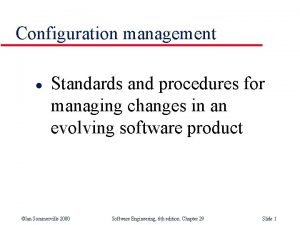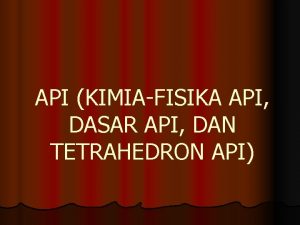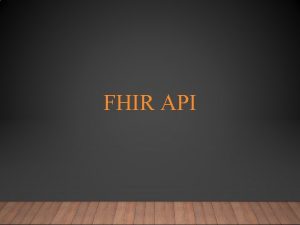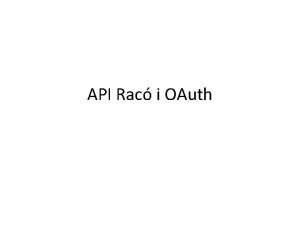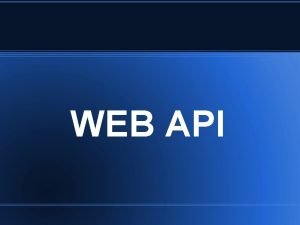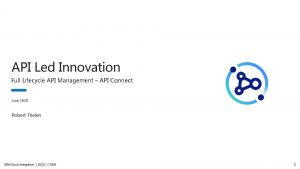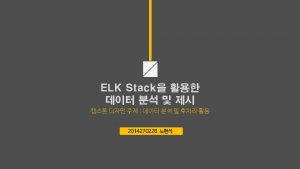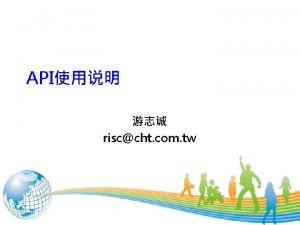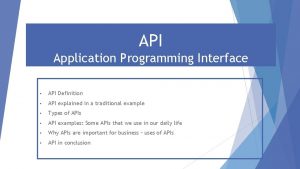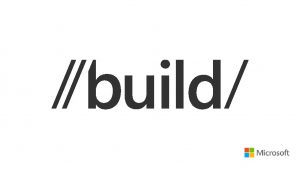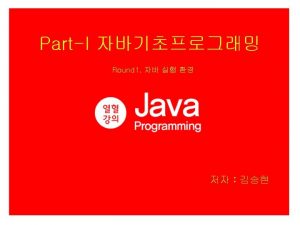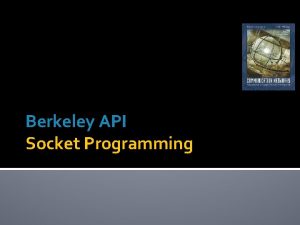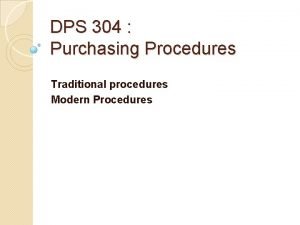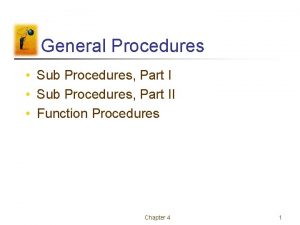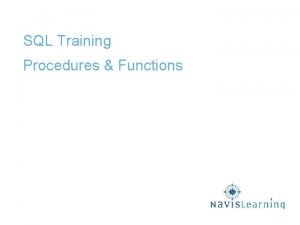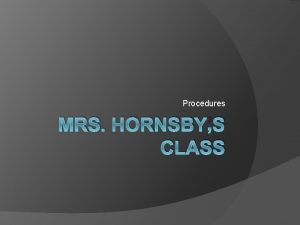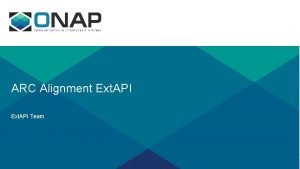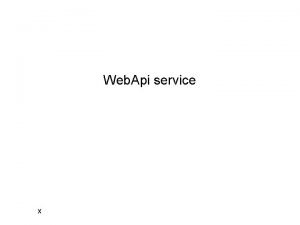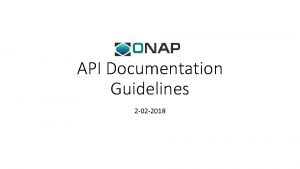API Procedures for Standards Development Standards 101 David





























- Slides: 29

API Procedures for Standards Development - ”Standards 101” David Miller, PE, F. ASCE Director, Standards 1

API is an ANSI accredited SDO Approved and Published Procedures – API’s procedures were approved and the program reaccredited by ANSI in July 2016, administrative update to procedures in July 2019 – API’s procedures detail the standardization development process consistent with ANSI’s “Essential Requirements: Due Process requirements for American National Standards”, 2020 Edition Regular ANSI Audits of API Program – Last audit completed 2016, next audit scheduled for August 2020 2

API Standards Program Accreditation • API is an American National Standards Institute (ANSI) accredited standards developing organization • ANSI accreditation requires: – – Openness, Balance, Consensus and Due Process Approved and Published Procedures Requirement for standards updates Regular Program Audits 3 3

API’s Approved Procedures contain seven sections: 1. Scope 2. Authority 3. Definitions 4. Designations 5. Procedures 6. Normative Policies 7. International Standards Activities 4

API’s Approved Procedures Section 1, Scope notes that the procedures were established to govern the development of standards published by API, and allows for Standards Committees to maintain their own internal policies and procedures 5

API’s Approved Procedures Section 2, Standards Authority API’s Standards Development has been authorized by the API Board of Directors, and is one of API’s oldest and most successful programs Use of all API standards is voluntary 6

API’s Approved Procedures Section 3, Definitions Defines the following terms: – – – Standards Action Standards Committees Subgroups Editorial Changes Substantive Changes Section provides for common understanding among standards committees 7

API’s Approved Procedures Key Definitions 3. 8 shall - Denotes a minimum requirement in order to conform to the standard. 3. 9 should - Denotes a recommendation or that which is advised but not required in order to conform to the standard. Note: In some cases, third parties or authorities having jurisdiction may choose to incorporate API standards by reference, and may mandate compliance with all requirements and recommendations. All uses of the words “should and “shall”, therefore, must be based on sufficient information of the standard’s current and potential future use. 8

API’s Approved Procedures Summary of terms used in API Standards: a) shall—is used to indicate that a provision is mandatory; b) should—is used to indicate that a provision is not mandatory, but recommended as good practice; c) may—is used to indicate that a provision is optional; d) can—is used for statements of possibility or capability. 9

API’s Approved Procedures Section 4, Designations Section defines what types of documents are considered standards, as follows: – – – Specifications Recommended Practices Standards Codes Bulletins and Technical Reports Terms such as guide, publication, or guidance document are not normally used in the title of API Standards 10

API’s Approved Procedures Section 5, Procedures Key section as it defines the process for approval, revision, reaffirmation, and withdrawal of API Standards Subsections are: – – – General Due Process Notification Resource Needs Membership on Standards Committees Balloting Interpretations Appeals Maintenance of Standards Meeting Procedures Effective Date 11

API’s Approved Procedures Section 5, Procedures Key section as it defines the process for approval, revision, reaffirmation, and withdrawal of API Standards Section details how API meets ANSI’s requirements for Openness, Balance, Consensus & Due Process API standards are revised, reaffirmed or withdrawn on a five-year cycle. “Stabilized” standards (non-safety, mature technology) may be reviewed on a ten-year cycle 12

API’s Approved Procedures 5. 2 describes balance: API seeks broad input to its standardization activities including the participation of all parties representing interest categories appropriate to the nature of the standard, and allows for open attendance at standards meetings (see 5. 10. 1). API strives for balanced representation (for example, targeting one-third representation for the traditional model of the three interest categories of operator-user, manufacturer-service supplier, and general interest) in an effort to avoid a majority of any one interest category. The criteria for balance are that a) no single interest category constitutes more than one-third of the membership of a consensus body dealing with safety-related standards or b) no single interest category constitutes a majority of the membership of a consensus body dealing with other than safety-related standards. 13

API’s Approved Procedures ANSI Essential Requirements: The standards development process should have a balance of interests. Participants from diverse interest categories shall be sought with the objective of achieving balance. If a consensus body lacks balance in accordance with the historical criteria for balance, and no specific alternative formulation of balance was approved by the ANSI Executive Standards Council, outreach to achieve balance shall be undertaken. Historically the criteria for balance are that a) no single interest category constitutes more than one-third of the membership of a consensus body dealing with safety-related standards or b) no single interest category constitutes a majority of the membership of a consensus body dealing with other than safety-related standards. RP 754, Process Safety Performance Indicators for the Refining and Petrochemical Industries, (ANSI/API RP 754) will need to specifically meet these requirements Targeted outreach began with the October 7 th, 2019 email 14

API’s Approved Procedures Section 6, Normative Policies – API Procedures referenced include: • Records Retention • Referencing Standards in API Standards • Intellectual Property Policy • Commercial Terms and Conditions • Metric Policy • Liaison with Other Organizations • On-line access to standards information 15

API’s Approved Procedures Section 7, International Standards Activities – Procedures for U. S. national adoption of ISO standards as American National Standards • U. S. Technical Advisory Group, or TAG, is governance body for these decisions • The TAGs are ANSI accredited committees 16

API Standards Summary - One of API’s foundational programs First API standard published in 1924, now ~700 standards covering all industry segments - Accredited and transparent process API is accredited by ANSI and follows its criteria for openness, balance, consensus and due process - Core of Institute’s Technical Authority API standards are heavily referenced by both Federal and State regulators - Basis for worldwide operations API standards are the most widely cited by international regulators 17 17

API Procedures for Standards Development – “Standards 101” Thank you for your attention! Contact Information: David Miller, PE, F. ASCE Director, Standards Development American Petroleum Institute 200 Massachusetts Avenue, NW Washington, DC 20001 miller@api. org, 202 -682 -8159 www. api. org/standards 18

API Procedures for Standards Development – “Standards 101” Informational Annex 19

API’s Approved Procedures Section 5, Procedures Key section as it defines the process for approval, revision, reaffirmation, and withdrawal of API Standards Subsections are: – – – General Due Process Notification Resource Needs Membership on Standards Committees Balloting Interpretations Appeals Maintenance of Standards Meeting Procedures Effective Date 20

API’s Approved Procedures Section 5. 1, General – Section covers approval, revision, reaffirmation, and withdrawal Section 5. 2, Due Process Standards activities open to all parties that have a direct and material interest, and balance on the Standards Committees is sought among interest categories Interest categories include (but are not limited to): – – – Operator-user Manufacturer General interest Standards are developed on the basis of consensus – substantial agreement, not necessarily unanimity – Consensus is defined as approval by a majority of those eligible to vote, and at least two-thirds of those voting, excluding abstentions 21

API’s Approved Procedures Section 5. 3, Notification Standards activities are properly announced Announcements include: – – – Federal Register ANSI Standards Action Newsletter API and other organization’s websites Section 5. 4, Resource Needs are Reviewed Prior to Commencement – – Project Justification/Needs Assessment Industry Practices/New or Emerging Technologies Potential Regulatory Impact/Adoption or Incorporation by AHJ Document Demand 22

API’s Approved Procedures Section 5. 5, Membership open to all individuals with direct and material interest in the standard being developed or revised API Committee and Subordinate groups are to be in compliance with applicable API policies Membership in API is not required to fully participate Committees may develop internal procedures 23

API’s Approved Procedures Section 5. 6, Balloting All standards actions are conducted by balloting Voting may take place at meetings, but must be ratified by letter ballot Actions requiring consensus balloting include approval, revision, withdrawal, or reaffirmation API ballots all standards action via the online web balloting tool API’s rules are “one organization – one vote” Negative ballots must be accompanied with documentation that includes: – – – Specific paragraph or section that the ballot pertains to Specific substantive reasons for objections Proposed wording to resolve objection 24

API’s Approved Procedures Section 5. 6, Balloting, continued Ballot Approval: – – – All comments must be considered Consensus reached, defined as approval by a majority of those eligible to vote, and approval by at least two-thirds of those voting, excluding abstentions New API Ballot Report automatically records consensus status Comment Resolution: – – – All comments must be considered Chairman is responsible for consideration of technical issues, API staff responsible for policy and procedures issues Comments can be resolved as follows: • • • Comments with affirmative ballots can be considered persuasive and editorial – change made, no reballoting Comments with affirmative ballots can be considered persuasive and substantive, requires reballoting Comments with affirmative ballots can be considered technically nonpersuasive and are not further considered 25

API’s Approved Procedures Comment Resolution, continued: – Comments can be resolved as follows: • • • Comments with negative ballots can be considered persuasive and substantive, requires reballoting Comments with negative ballots can be withdrawn after consultation with Chairman, must be confirmed in writing Comments with negative ballots can be considered technically nonpersuasive or found unrelated to item being balloted, and not further considered but must be recirculated Notification: – Individuals submitting comments and all committee members must be notified in writing the resolution of their comments, meeting minutes can serve this purposed Reballoting: – – – Reballoting is required if substantive changes are made as a result of comment resolution Entire document or only portions can be reballoted Same procedures but a shorter period is allowed 26

API’s Approved Procedures Section 5. 7, Interpretations – – – Interpretation is answer to a question on the meaning of a standard Requests must be made in writing Only API staff are authorized to issue interpretations API staff can consult with committee members, but no competing suppliers or manufacturers Interpretations are then published or posted electronically 27

API’s Approved Procedures Section 5. 8, Appeals – – – – Any person having a material interest may file an appeal Appeals must be made within 30 days of notification in writing Standards Director investigates and responds within 45 days Committee responsible for standard forms Appeal Board and hears appeal Hearing provides opportunity to present case Decision to be provided within 45 days of hearing Further right to appeal then on procedural, not technical basis 28

API’s Approved Procedures Section 5. 9, Maintenance – – – All standards must be revised, reaffirmed, or withdrawn every five years Standards committee may ask parent committee for two year extension Reviews of draft standards are to be performed no later than two years after issuance, with the option of extending the comment period for two more years, conversion to a full standard, or withdrawal Section 5. 10, Standards Meeting Procedures – – – Meetings to be held as needed Call for Meetings must be accompanied with agendas Meeting minutes must reflect participants and actions taken Section 5. 11, Effective Date – Generally date published but can be extended due to program needs 29
 Auditing standards differ from auditing procedures
Auditing standards differ from auditing procedures Software configuration management basics and standards
Software configuration management basics and standards Fspos vägledning för kontinuitetshantering
Fspos vägledning för kontinuitetshantering Typiska drag för en novell
Typiska drag för en novell Nationell inriktning för artificiell intelligens
Nationell inriktning för artificiell intelligens Returpilarna
Returpilarna Varför kallas perioden 1918-1939 för mellankrigstiden
Varför kallas perioden 1918-1939 för mellankrigstiden En lathund för arbete med kontinuitetshantering
En lathund för arbete med kontinuitetshantering Särskild löneskatt för pensionskostnader
Särskild löneskatt för pensionskostnader Tidbok yrkesförare
Tidbok yrkesförare Anatomi organ reproduksi
Anatomi organ reproduksi Densitet vatten
Densitet vatten Datorkunskap för nybörjare
Datorkunskap för nybörjare Tack för att ni lyssnade bild
Tack för att ni lyssnade bild Debattartikel struktur
Debattartikel struktur Delegerande ledarstil
Delegerande ledarstil Nyckelkompetenser för livslångt lärande
Nyckelkompetenser för livslångt lärande Påbyggnader för flakfordon
Påbyggnader för flakfordon Vätsketryck formel
Vätsketryck formel Offentlig förvaltning
Offentlig förvaltning Jag har gått inunder stjärnor text
Jag har gått inunder stjärnor text Presentera för publik crossboss
Presentera för publik crossboss Jiddisch
Jiddisch Kanaans land
Kanaans land Treserva lathund
Treserva lathund Luftstrupen för medicinare
Luftstrupen för medicinare Claes martinsson
Claes martinsson Cks
Cks Byggprocessen steg för steg
Byggprocessen steg för steg Bra mat för unga idrottare
Bra mat för unga idrottare

